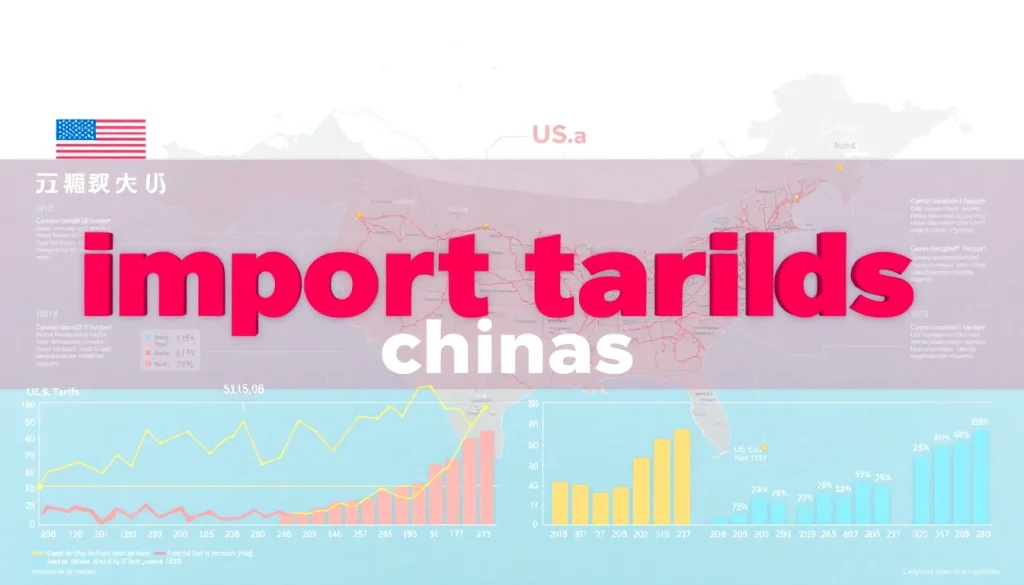Understanding the Impact of Import Tariffs on China: Current Trends and Future Implications

Introduction to Import Tariffs in China
Import tariffs are a critical aspect of international trade, playing a significant role in shaping the economic relationships between countries. Import tariffs in China have been particularly influential in the ongoing economic dialogue between the U.S. and China. Understanding these tariffs not only helps businesses navigate the complexities of international trade, but it also provides valuable insights into the broader economic landscape.
What Are Import Tariffs?
Import tariffs are government-imposed fees on imported goods, aimed at increasing the price of foreign products to encourage domestic consumption. These tariffs can be levied as a percentage of the total value of the goods or as a fixed amount per unit. By doing so, governments aim to protect local industries from foreign competition, generate tax revenue, and sometimes influence political decisions through economic means.
The Role of Tariffs in International Trade
Tariffs serve multiple purposes in international trade. First, they help protect nascent industries in developing countries by allowing them to grow without the immediate threat of competition from established foreign companies. For developed nations, tariffs often function as a tool of economic policy that can be wielded in trade negotiations.
Additionally, tariffs impact the flow of goods between nations. They can affect market accessibility, influence consumer choices, and ultimately alter the landscape of international trade agreements. In the case of U.S.-China relations, tariffs have become a prominent feature of the ongoing trade negotiations, reflecting not only economic factors but also political sentiments.
Impact of Tariffs on U.S.-China Relations
The tariffs imposed by the U.S. on Chinese imports have significantly influenced bilateral relations between these two economic powerhouses. The tensions escalated during the Trump administration, with tariffs reaching unprecedented levels—peaking at 145% on some goods.
Trade deals aimed at resolving these tensions have resulted in variable tariffs at different stages, including reductions following negotiations. The latest agreement mentions a tiered tariff system that ranged from a baseline of 10% reciprocally to a staggering 55% on select imports. This complex interplay of tariffs underscores the fragile nature of international relationships in the face of competitive economic practices.
Current Import Tariff Rates on Chinese Goods
Overview of Effective Tariff Rates
As of recent data, effective U.S. tariffs on imports from China stand at an average of approximately 30%, subject to variation based on the type of goods imported. This is a considerable reduction from prior years when tariffs soared over 140% but still indicates a high cost of doing business when it comes to trade with China. Understanding these rates is crucial for businesses looking to import goods, as they can directly affect pricing strategies and profit margins.
Comparative Analysis of Tariff Rates
When comparing tariff rates across different nations, it is evident that U.S. tariffs on Chinese goods are significantly higher than those imposed on imports from many other countries. For example, typical tariffs on imports from countries that hold a most-favored-nation (MFN) status hover around 10%. This 20% premium on Chinese imports creates an uneven playing field that affects competitiveness in various industries, from electronics to textiles.
Additionally, the variation in tariffs by product category highlights the complexity of U.S. trade policy. Certain products may be subjected to higher tariffs due to national security concerns or strategic economic interests, further complicating import strategies for U.S. businesses.
Impact of Recent Agreements on Tariffs
Recent trade agreements, particularly those engaged by the Biden administration, have sought to stabilize tariffs at a sustainable level. These agreements focus not only on tariff reductions but also on broader issues such as intellectual property rights and labor standards. The implementation of the latest trade agreement has introduced provisions that can make import processes smoother, potentially lowering costs in the long run.
Further, the negotiation process often invites opportunities for businesses to engage in advocacy, urging policymakers to consider the interests of industry stakeholders during subsequent talks. Understanding the nuances of these agreements can provide companies with strategic insights into planning their imports and exports effectively.
Effects of Tariffs on Businesses and Consumers
How Tariffs Affect Import Prices
Tariffs directly influence the cost of imported goods, affecting both businesses and consumers. The increased cost imposed by tariffs often gets passed down to the consumer, leading to higher prices for everyday products. For example, electronics, clothing, and automotive parts that face high tariffs can see price increases ranging from 20% to 50% depending on the tariff rate and the competition in the market.
This price elasticity indicates how sensitive consumers are to changes in price, thus influencing their purchasing decisions. A significant increase in prices can lead to a shift in consumer behavior, potentially steering them toward domestic products or lower-cost alternatives from other countries.
Impact on Consumer Choices and Spending
The overall impact of tariffs can lead to a decrease in discretionary spending. As consumers are faced with higher prices on imported goods, they may prioritize essential purchases, which can affect sectors of the economy that rely on consumer spending for growth.
Furthermore, consumers may also adapt by seeking out less expensive alternatives or altering their buying habits to minimize their exposure to higher tariff rates. This behavioral shift underscores the importance of price elasticity regarding the effectiveness of tariffs on influencing market dynamics.
Strategies for Businesses to Mitigate Tariff Costs
To navigate the challenges presented by import tariffs, companies can adopt several strategies. One effective approach is supply chain diversification—sourcing materials and products from multiple countries to minimize reliance on any one market, particularly China.
Additionally, businesses can leverage technology and automation to improve efficiency and reduce operational costs, thus absorbing some of the tariffs’ financial impact. Strategic planning, including the adaptation of pricing strategies and product offerings, ensures businesses remain competitive despite the adverse effects of tariffs.
Future Predictions for Import Tariffs
Analyzing Economic Indicators
The future of import tariffs is intrinsically linked to various economic indicators, including GDP growth, inflation rates, and international trade balances. Analysts predict that as the global economy stabilizes post-pandemic, there may be a reassessment of tariffs, especially in sectors heavily impacted by COVID-19 supply chain disruptions.
The fluctuations in these economic indicators will guide government policy and international negotiations, particularly with looming elections influencing the priorities of trade policies. Businesses must remain agile, continuously monitoring economic trends to adapt their operational strategies accordingly.
Potential Changes in U.S.-China Trade Policy
Given the complexity of U.S.-China trade relations, potential changes in tariffs and trade policies could arise from ongoing diplomatic negotiations. The Biden administration may pursue a more collaborative approach in addressing trade imbalances, which may involve gradual tariff reductions aimed at alleviating consumer prices and supporting economic recovery.
Should tariff negotiations progress positively, companies may benefit from improved trade conditions that can lead to enhanced access to Chinese markets and lower costs. However, businesses should also prepare for sudden shifts in policy that may arise based on geopolitical factors or domestic economic pressures.
Expert Opinions on Future Tariff Developments
Industry experts and economic analysts have differing views on the trajectory of future tariff developments. Some believe that the current trend towards higher protectionism will continue, while others argue that global economic interdependencies demand a more open trading framework.
Regular participation in trade associations and economic forums can give companies insight into these expert opinions, allowing them to position their strategies proactively relative to emerging tariff trends and policy changes.
Conclusion: Navigating Tariffs as a Competitive Advantage
Summarizing Key Takeaways
Understanding the complexities of import tariffs, especially concerning China, is paramount for businesses operating in the international market. As trade dynamics shift, staying informed about tariff rates and their implications can help businesses make strategic decisions.
Strategic Planning for Businesses
Developing adaptive strategies to navigate tariffs is essential for maintaining profitability and competitive advantage. By diversifying sourcing strategies, optimizing supply chains, and staying informed, businesses can mitigate risk and position themselves favorably in the market.
Encouraging Advocacy for Fair Trade Policies
Finally, businesses and industry stakeholders should advocate for fair trade policies that consider the complexities of global trade while also promoting domestic interests. Engaging in dialogue with policymakers and participating in trade organizations can strengthen these efforts and lead to more favorable outcomes in future trade negotiations.







